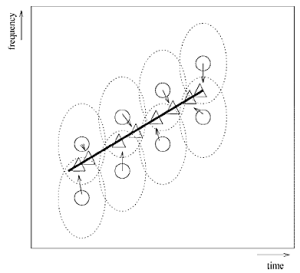Reassigned FFT
The reassigned spectrogram is especially suited for "fast" spectrograms, wich can offer better resolution in the time, as well as in the frequency domain.
Principles
 The distribution of the energy in a chirp : the dashed ellipses represent the analysis windows. Circles represents the geometric center of the analysis window. Triangles represent the center of gravity of the energy. | The energy distribution in the spectrum is calculated with an STFT, but the energy of the partials, as well as that of the transients is reassigned to increase the frequency and time resolution. To execute a sonogram analysis, we usually have to find a balance between frequency resolution and time resolution. It is possible to get better resolution, within limits. The reassignment of the energy amounts to using information from the phase spectrum to sharpen the amplitude spectrum. Simple sinusoids, linear chirps, and impulses at the correct frequency or time are located with a higher resolution. The energy is reassigned from the geometrical center of the analysis window to the center of gravity of the energy. |

Access and Parameters
To execute a reassigned FFT analysis, select the Analysis/Sonogram Analysis menu and choose the Reassigned Spectrum menu item in the Analysis Type menu.
The parameters of the reassigned FFT are similar as those of an FFT.
